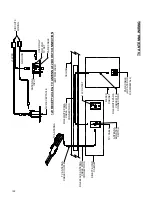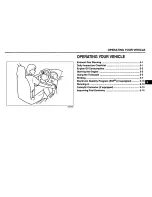
107
Wood Product Care
Remove dust with a clean slightly damp cloth. Ap-
ply a quality furniture polish and buff with a soft, dry
cloth. Never use harsh detergents and solvents.
Laminate Top Care
Use a mild dishwashing liquid with warm water to
clean your laminate tops. Use a soft cloth for both
washing and drying. Abrasive cleaners, steel wool or
gritty cleaners will damage the surface.
Power Range Hood
Clean the filter in detergent and hot water periodically
and wipe down the surface of the unit with mild soap
and water. Use a soft cloth for both washing and
drying.
Refrigerator
Clean interior with mild soap and water after each
trip. Defrost freezer and empty ice trays. When de-
frosting, be sure that the drip tray is in place under
the finned evaporator - defrost water will be carried
through a tube from the drip tray to the bottom of the
trailer overhang below the refrigerator. Periodically
check the drain tube to assure it does not become
plugged. Leave the door open after cleaning.
Drains
If a stoppage develops in the sink or shower drain,
DO NOT use lye or any strong chemicals. Strong
chemicals can harm the plastic in your waste system.
A standard wire drain cleaner is recommended.
Shower Care
For routine cleaning use a non-abrasive cleaner.
Household fiberglass cleaners are recommended.
Never use harsh detergents or abrasive cleaners.
Never use a razor blade or steel wool to clean the
surfaces.
Sink Care
Do not use abrasive cleaners or scouring powders.
Use of abrasive cleaners will dull or damage the
surface of this product and could leave scratches. If
material gets scratched, easy polishing brings back
the original shine. It is recommended you use a gel
cleaner or household cleaner made for fiberglass
and acrylic. Do not use scouring pads, steel wool,
“scotch brite” type scratch pads, or any other abra-
sive scrubbers. Wipe only with a soft cloth or sponge.
Always use a cutting board or a sink protector when
using knives or sharp objects. It is recommended that
you use protective mats, racks, or dishpans to help
protect your sink. Always allow pans to cool before
setting them in your sink.
Summary of Contents for 1130
Page 6: ...6 This page intentionally left blank ...
Page 8: ...8 This page intentionally left blank ...
Page 10: ...10 This page intentionally left blank ...
Page 12: ...12 This page intentionally left blank ...
Page 22: ...22 This page intentionally left blank ...
Page 28: ...28 This page intentionally left blank ...
Page 34: ...34 This page intentionally left blank ...
Page 48: ...48 This page intentionally left blank ...
Page 54: ...54 This page intentionally left blank ...
Page 60: ...60 This page intentionally left blank ...
Page 68: ...68 This page intentionally left blank ...
Page 76: ...76 This page intentionally left blank ...
Page 86: ...86 This page intentionally left blank ...
Page 89: ......
Page 94: ...94 This page intentionally left blank ...
Page 113: ...113 SCHEMATICS ...
Page 120: ...120 ...
Page 121: ...121 ...
Page 123: ...123 ...
Page 131: ...131 ...
Page 132: ...132 ...
















































